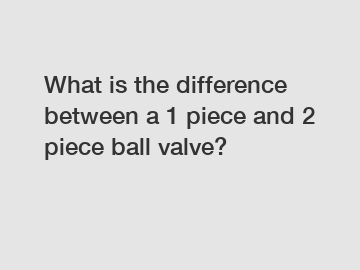Dec. 23, 2023
Mechanical Parts & Fabrication Services
Cencho are exported all over the world and different industries with quality first. Our belief is to provide our customers with more and better high value-added products. Let's create a better future together.
When it comes to fluid control applications, valves play an indispensable role. Among the various valve types, ball valves are highly regarded for their excellent sealing capabilities and efficient operation. However, it's crucial to understand the nuances between different ball valve designs to make the right choice for your specific application. In this article, we will delve into the differences between 1-piece and 2-piece ball valves, shedding light on their unique features and benefits.
1. What are Ball Valves?

Before we explore the differences between 1-piece and 2-piece ball valves, let's briefly discuss the general concept of ball valves. A ball valve is a quarter-turn valve that uses a hollow, perforated, and pivoting ball to control fluid flow. The ball contains a through hole, which, when aligned with the valve body, permits flow, whereas rotating the ball by 90 degrees obstructs the flow, effectively shutting off the valve.
2. Understanding 1-Piece Ball Valves:
A 1-piece ball valve is constructed from a single body, with all components integrated into a single unit. The ball itself is fixed in place by the valve body. This design significantly reduces potential leak paths, making it an ideal choice for critical applications where tight shut-off is crucial. Due to their compact size and straightforward construction, 1-piece ball valves are often favored in scenarios requiring low-cost, low-pressure, and low-temperature applications.
Advantages of 1-Piece Ball Valves:
a) Enhanced Leak Resistance: With fewer joints and potential leak points, 1-piece ball valves offer superior leak resistance, ensuring reliable operation and minimized product loss.
b) Easy Installation: The compact design and simplified construction of 1-piece ball valves allow for easy installation, making them a convenient choice for numerous applications.
3. Unraveling 2-Piece Ball Valves:
As the name suggests, 2-piece ball valves comprise two distinct pieces: the valve body and the ball. The valve body consists of two separate halves that are structurally bolted together, enclosing the ball inside. This construction offers more flexibility in terms of repair and maintenance, as the valve body can be disassembled without disturbing the pipeline.
Advantages of 2-Piece Ball Valves:
a) Simple Maintenance: The ability to disassemble the valve body facilitates easy access to the internals, simplifying maintenance and reducing downtime.
b) Flexibility: 2-piece ball valves are excellently suited for applications that may require periodic adjustments or repairs. The removable valve body enables swift repairs or replacements without disrupting the pipeline.
4. Comparison: When to Choose 1-Piece or 2-Piece Ball Valves.
Both 1-piece and 2-piece ball valves offer distinct advantages depending on the application requirements. To make an informed decision, consider the following factors:
a) Budget Constraints: If cost efficiency is a priority without compromising performance, 1-piece ball valves provide an economical solution for low-pressure applications.
b) Critical Applications: For applications demanding exceptional seal integrity and reduced leak potential, 1-piece ball valves are often preferred due to their tight shut-off capabilities.
c) Maintenance and Repair: In scenarios where convenient maintenance and repair are necessary, 2-piece ball valves offer flexibility by allowing dismantling without disrupting the pipework.
5. Conclusion:
In summary, understanding the differences between 1-piece and 2-piece ball valves is essential in selecting the right valve for your fluid control needs. While 1-piece valves excel in leak resistance and compactness, 2-piece valves provide advantages in ease of maintenance and repair. Each type has its specific applications, and careful consideration of factors such as cost, criticality, and process requirements will help steer your decision in the right direction.
At [Company Name], we offer a wide range of ball valves to cater to diverse industrial needs. Our team of experts is always available to provide professional guidance and assist you in selecting the most suitable valve for your specific application.
Are you interested in learning more about Customized Investment Castings? Contact us today to secure an expert consultation!
If you are interested in sending in a Guest Blogger Submission,welcome to write for us!
All Comments ( 0 )